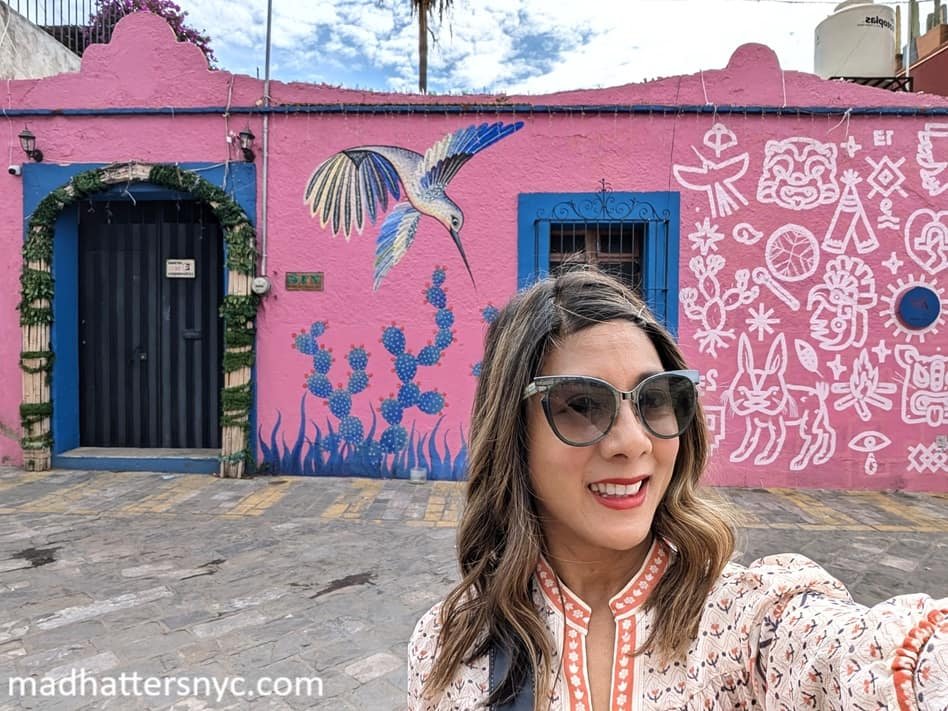A Self-Guided Walk Through Xochimilco: Oaxaca’s Historic and Cultural Gem
With incredible street art on every corner, a stroll through Xochimilco was a sensory feast that left me captivated and inspired. This easy self-guided walk maps out my path through the barrio’s picturesque streets, with a few bonus stops along the way to highlight the city’s history and culture. If you’re spending some time in magical Oaxaca, don't miss the chance to add this to your travel itinerary.
Where is Xochimilco?
Xochimilco is located just north of Oaxaca’s Centro district and west of its Reforma and Jalatlaco neighborhoods. The neighborhood is easy to access, with the starting point of this self-guided walking tour just 10 minutes away from the Temple of Santo Domingo. It’s also an easy area to navigate on foot. The map above highlights key stops along the way; you can open a full-size map to help you explore.
How much time do I need for Xochimilco?
A quick stroll through the neighborhood can be completed in under an hour, but allowing 2-3 hours so you can linger and explore would be ideal.
What makes Xochimilco unique?
Xochimilco is one of the oldest neighborhoods in Oaxaca and it carries a rich history dating back to pre-Hispanic times. Its name, derived from the Nahuatl words "xochitl" (flower) and "mīlco" (place), translates to "place of flowers," reflecting the area's long-standing connection to natural beauty and cultivation.
Historical landmarks abound in Xochimilco, each with its own story to tell. But today, it's also a vibrant artistic hub, with an abundance of trendy eateries. The fusion of indigenous, colonial and contemporary influences is evident throughout Xochimilco.
Walking Through the Heart of Xochimilco
Mercado Sánchez Pascuas
Flower vendors outside Mercado Sánchez Pascuas
We'll start our walk at Mercado Sánchez Pascuas, which is a perfect introduction to the colorful street art and vibrant local culture we're about to explore.
Mercado Sánchez Pascuas is a bustling marketplace that offers a genuine glimpse into everyday life in Oaxaca. As you step inside, you are immediately greeted by a riot of colors, sounds, and aromas. The market is renowned for its selection of traditional Oaxacan ingredients and delicacies. Its vibrant energy reflects the strong sense of community and tradition that characterizes Xochimilco. Outside, beautiful, colossal murals provide the backdrop for colorful flower vendors. I visited on a Saturday morning, when locals were sitting under the tree in the parking lot enjoying the meals they had procured from the market, slightly amused as I made my way around them taking photos of the colorful walls.
Rito Chocolateria
The use of cacao in Oaxaca can be traced back to the Zapotec and Mixtec civilizations, long before the arrival of the Spanish. Cacao beans were considered a divine gift and were often used in religious ceremonies, as offerings to the gods, and even as a form of currency. In Oaxaca, chocolate is far more than a treat; it is a symbol of cultural heritage, a link to ancient traditions, and a vital part of the social and culinary landscape. So after you’ve had your fill of the market, cross the street and step into Rito Chocolateria, where you can find a variety of chocolate products, including bars, powders, prepared drinks and more. Oaxacans often start their day with a cup of hot chocolate, so consider this the perfect excuse to indulge in all of their delicious offerings in the name of cultural exploration.
The chocolate ice cream is particularly popular, but don’t miss the opportunity to try the award-winning Chocolate Pataxtle bar by Reina Negra. Pataxtle is a species of cacao, which is sometimes called white cacao due to the color of its seeds. It’s a more fibrous, nutty cousin of regular cacao, and gives the chocolate an earthy, rich flavor.
The Arches of Xochimilco
From Rito Chocolateria, take a right on Cosijopi then turn left onto Calle de Manuel Garcia Vigil, a charming cobblestone street lined with colorful buildings. As you make your way along it, you may be tempted to wander into Terrenal, a hybrid cafe-shop-gallery in a beautiful colonial building, or Xanté Arte, a boutique that specializes in clothing with unique prints and illustrations.
But soon, you’ll come across the beautiful Arches of Xochilmilco. Made of baked clay brick, the arches were originally part of the San Felipe Aqueduct, a critical piece of infrastructure dating back to the mid-18th century. The aqueduct would carry water from the town of San Felipe, through the Xochimilco neighborhood, and across the Jalatlaco River, supplying the entire city.
If the Arches look familiar, it’s likely because they were featured in the 2006 smash hit Nacho Libre, starring Jack Black. In fact, the alley where Nacho meets Esqueleto for the first time is a bonafide tourist attraction. Although the gates to the alley were closed when I visited, a local saw me taking photos and offered to open them so I could enter, though I declined to trouble them. When my brother visited, however, he didn’t miss the chance to strike a pose in the Nacho crouch!
Plazuela de la Cruz de Piedra
Exterior of Cafe El Volador at Plaza Cruz de Piedra
Right by this stretch of the aqueduct is also the famous Plaza Cruz de Piedra, a charming square named after the large cross that stands at its center. Local lore tells of a tragic accident that took place about 60 years ago, leading the residents to campaign for a large cross to be erected, primarily to bless the spot, but secondarily to discourage vehicular traffic. It eventually became a landmark, and after decades of wear and tear, the cross was replaced with a stylish, modern interpretation. The plaza is now a popular site for photo shoots due to its eye-catching aesthetics, and is also a gathering point for celebrations and parades like the ones that take place during the Guelaguetza in July.
Calle Rufino Tamayo
Continuing along Calle Rufino Tamayo, you’ll be able to appreciate how many of the Arches of Xochimilco now serve as entrances to private residences and businesses. Many feature creative adornments, and when combined with the colorful buildings and extraordinary murals, make for an eye-catching stroll. There are also a number of cafes along this path where you can stop for a break, if so desired.
It’s worth noting that Rufino Tamayo (1899-1991) is one of Mexico's most celebrated artists, and his deep connection to Oaxaca has made him a significant figure in the region's cultural heritage. Born in Oaxaca City, Tamayo's work spans painting, printmaking, and sculpture, and his unique style has left an indelible mark on both Mexican and international art.
Tamayo was born to a Zapotec mother and a mestizo father, and his indigenous roots profoundly influenced his artistic vision. Orphaned at an early age, he moved to Mexico City to live with an aunt, where he later attended the San Carlos Academy of Fine Arts and was exposed to a variety of artistic movements and traditions that shaped his eclectic style. Museo Rufino Tamayo in Oaxaca’s downtown area houses a significant collection of pre-Columbian art that Tamayo personally collected and curated. It reflects his deep appreciation for his indigenous heritage and his desire to preserve and celebrate it.
Callejon Morelos
I took a right down Callejon Morelos, a small side street connecting Calle Rufino Tamayo to the parallel Calle Macedonio Alcala, and found quite a few additional murals that were absolutely worth the detour.
Calle Jose Lopez Alvarez
Once you arrive at Oaxaca’s Highway 190, (carefully!) cross at the light, and continue straight on Calle Jose Lopez Alvarez. The density of murals increases significantly, with a combination of large-scale, full-wall creations to petite doorway frames available to enjoy. Again, cafes and shops line the streets and offer worthwhile distractions. Corazón de Cacao is a chocolateria where the owner’s recipes have been handed down for generations, and generous samples are offered.
Ancestral
If you haven’t filled up too much along the way and have arrived at a time suitable for a meal, then consider a stop at Ancestral. The eatery’s lush surroundings make you feel like you’re in a secret garden, and its menu features a host of local, traditional favorites. Depending on where you’re seated, you might even be able to enjoy watching the cooks at the comal (griddle) near the entrance. Oaxaca is known for its many gastronomic delights, so it seems a waste not to take advantage of all it has to offer. Founded in 2017 by Chef Miguel Mijangos, Ancestral is one of the many Oaxacan eateries featured in the Michelin Guide. It has also earned a spot on the Mexico Gastronomic Guide of Culinary Mexicana, a handpicked list of restaurants that best represent the culinary spirit of Mexico.
Pro Tip: Be sure to check the hours prior to your visit because the restaurant closes for a period between their official breakfast and lunch/dinner hours. Better yet, consider making a reservation.
If you’re looking for something more casual, a.m. Siempre Cafe next door is also a popular spot with many positive reviews. As its name suggests, the menu is breakfast and brunch-themed.
BS Children's Library of Oaxaca
If you’re traveling without children, stopping into a children’s library might seem an odd choice. But thanks to this beautifully written Curbed article, I learned that this particular library in Xochimilco is an architectural delight and made a point to visit.
Juan José Santibañez is a distinguished Mexican architect known for his innovative and thoughtful designs that seamlessly blend functionality with aesthetic appeal. The BS Children's Library is a shining example of his commitment to creating inclusive and inspiring environments for education and community engagement. Of particular interest is how the structure was built around existing trees instead of on top of them, as well as the oculus in the foyer.
You’ll have to leave your bag at the entrance, but the terraced outdoor courtyard is a good place to sit for a minute and catch up on emails or plan your next Oaxacan adventure.
San Felipe Aqueduct
Once you exit the library, continue onwards on Calle Jose Lopez Alvarez, and in a few short minutes you’ll arrive at the San Felipe Aqueduct. When you consider the Aqueduct and the Arches of Xochimilco as a cohesive system, the scale of this engineering marvel comes into focus. Another point of wonder is that this system, which was built in the 18th century, continued to provide water to Oaxaca until after 1940.
From here, I turned around and simply retraced my steps. If you’re heading back towards Santo Domingo de Guzman, once you cross over Highway 190, you could choose to walk down Calle Porfirio Diaz instead of Calle Rufino Tamayo. There are a couple of benefits for switching up the route back: one is the opportunity to stop at Pan Con Madre off Calle de Quetzalcóatl, where a number of bready delights await. Another is the many art studios and galleries along the way you can choose to wander in and out of.
Or, if it’s a nice day and you’d like to explore another neighborhood, give Jalatlaco a try. With an abundance of great eateries, coffee shops, and art galleries, the neighborhood is an enjoyable place to pass the time. The street art of Jalatlaco is another fun way to delve into Mexico’s rich culture and traditions.
Conclusion
Xochimilco offers a unique blend of cultural, historical, and sensory experiences. This charming neighborhood not only showcases Oaxaca's architectural and artistic heritage but also embodies the community spirit and traditions that make this city so special. As you explore Xochimilco, you'll discover why this gem is a must-visit, capturing the heart and soul of Oaxaca in every step.


















